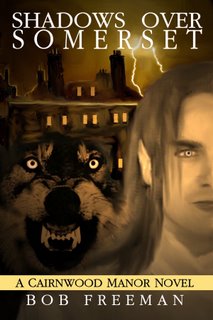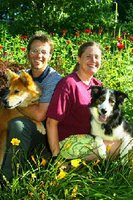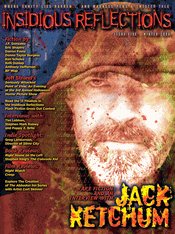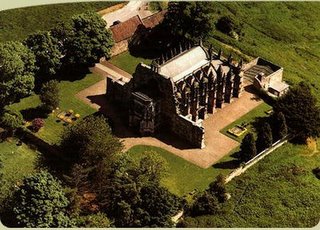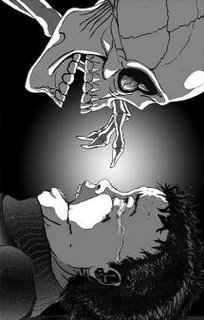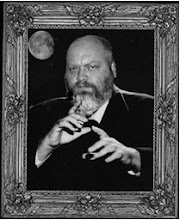Scotsman.com is looking for the Seven Wonders of Scotland and have compiled a list of thirty candidates... I'll list my seven later in the week, but for now give the list a gander and think upon it. Which of these thirty treasures deserve to make the list of seven?The prehistoric treasures of OrkneyWithin a few windy miles on Orkney is a collection of standing stones which predate Stonehenge and the Pyramids. Maeshowe, the Ring of Brodgar, Stenness and Skara Brae, which are all World Heritage Sites, are potent symbols of the culture which predated and helped create Scotland.
The Borders abbeys
It is hundreds of years since Melrose, Dryburgh, Jedburgh and Kelso abbeys have been used for worship, but their picturesque remains are an integral feature of the Borders landscape. Framed by rivers, forest and gentle hills, their association with Walter Scott, Robert the Bruce and Mary Queen of Scots have made them an inspiration for centuries.
The Scottish sense of humour
Whether it comes from our intelligence, our ability to laugh at ourselves, or a mechanism to cope with the cold dark weather, the Scots sense of humour is unique. Laughter is the perfect foil to the Celtic gloom and "enjoying the craic" is one of the most universal aspects of life from Gretna to Wick and beyond.
The Cuillin of Skye
Stunning views of the Hebridean islands and peaks that challenge even experienced climbers make the towering black ridge of the Cuillin a playground for mountaineers. Those who have mastered it speak of an outstanding sense of freedom and an astonishing play of colours on land and sea.
Single malt whisky
The pure water, the clear fresh air and the peat moorlands of Scotland all contribute to the flavours of single malt whisky, the water of life and one of our great offerings to the world. The combination of water, malted barley and yeast result in hundreds of distinctive flavours, from the smoky island malts to the sweet ambrosia of Speyside.
The Caledonian Canal
One of the great feats of engineering, Thomas Telford's chain of locks at the start of the Caledonian Canal was conceived in the Napoleonic era and designed to be deep enough to take a naval frigate. With views of Ben Nevis and the azure coast of Lochaber, the canal is a stunning example of man's determination to master the forces of nature.
IonaThe exiled home of St Columba and the burial place of Scottish Kings continues to be a place of pilgrimage for those seeking the source of Celtic Christianity. With white sand beaches and clear turquoise seas, this tiny island is famous worldwide as a place of great power and a symbol of spirituality and peace.
The ancient Caledonian Forest
From Glen Affric to Abernethy and the Black Wood of Rannoch, the Caledonian Forest of today is just a fragment of the vast swathes of woodland which once spread across the country. Magical and transcending, these patches of ancient forest are a vital part of our natural heritage, domain of the mighty Scots pine and a precious habitat for wildlife.
The architecture of Charles Rennie Mackintosh
Architect, painter and designer Charles Rennie Mackintosh left a great legacy to Glasgow with his distinctive buildings, in which even the furniture was created to his specifications. The House for an Art Lover, the Glasgow School of Art, the Willow Tea Rooms and the Lighthouse are all beautiful and distinctive, stamped with a recognizable flourish which even today is used to epitomise the Glasgow style.
Arthur's Seat and Salisbury Crags
How many cities in the world have a skyline dominated by the plug of a long-extinct volcano? Arthur's Seat and Salisbury Crags bring the rugged elemental beauty of Scotland into the heart of the city, while its distinctive rock formations inspired the father of modern geology, James Hutton.
Ben NevisThe easy southern slopes of Britain's tallest mountain can be explored by walkers, while the steep buttresses and ridges to the North are a stern test for dedicated climbers. Mountaineers speak of huge hidden crevasses where you can lose yourself for hours and of unparallelled panoramic views stretching from the Cairngorms to the Highland lochs.
Dolly the Sheep & Scots inventivenessThe world discovered Dolly the Sheep in 1997, when she became internationally famous as the first live mammal ever cloned from an adult cell. Embryologist Ian Wilmut and his team at Roslin Institute continue a long tradition of Scottish ingenuity, which has given an astonishing number of inventions to the world.
The Edinburgh Festivals
In August the capital is transformed into a cultural wonderland with the world's greatest ballet companies and finest authors rubbing shoulders with television executives, talent scouts and countless comedians. The streets of a city which can sometimes be dour become a riot of colour and a living celebration of the arts in every guise.
Edinburgh Old and New Towns
With a stunning natural setting and a magnificent skyline, Edinburgh is a treasury of architectural marvels, from the cobbled labyrinth of the old walled city to the elegant Georgian splendour of the New Town. Every step is paved with history, from the towering achievements of the Enlightenment to the heinous crimes of grave robbers Burke and Hare.
Fingal's Cave and StaffaTo stand inside the great basalt cathedral of Fingal's Cave was an important part of the Grand Tour and this rocky Hebridean outcrop continues to inspire thousands of visitors to this day. Immortalised by Felix Mendelssohn in the Hebrides Overture and painted by Turner, Fingal's Cave is awash with romantic legend.
The Forth Bridge
When it was built, the Forth Bridge was regarded as the eighth wonder of the world and it remains one of the most recognisable structures in Scotland. Sir John Fowler and Benjamin Baker's bridge is a testament to robust Victorian engineering and casts a magnificent silhouette across the waters of the Forth.
Glasgow's shipyards
Tens of thousands of men once worked on the shipyards of the Clyde and many of the ships they built are still in service today. Glasgow's shipbuilding industry helped forge the steely character of the city and apprentices including Sir Alex Ferguson and Billy Connolly began their working lives there.
GlencoeTowering mountains and ever-changing weather characterise the eerie glen, redolent of the ghosts of one of the most bloody episodes in Scottish history. Standing in the depths of the valley, one cannot fail to be overpowered by the landscape and the almost tangible presence of the past.
Golf
Scotland is not only the home of golf and the place the rules were first laid down, it also contains some of the world's most spectacular courses, including five which are used in the Open Championship. Stunning scenery, undulating greens and testing conditions make courses such as St Andrews among the finest in the world - and a place of pilgrimage where all golfers dream of refining their skills.
The kilt
Not only is the kilt a national form of dress, which keeps alive the tradition of the clan tartan and identifies Scots at formal gatherings around the world, it is also a design classic. French designer Jean Paul Gaultier is a fan, Vivienne Westwood created a punk version and Howie Nicholsby of Edinburgh has made plain kilts in leather and denim for stars including Vin Diesel and Robbie Williams.
The light and sky of ScotlandFrom the vast skies of Orkney to the cool clear light of the east coast and the blazing pink and orange of the Hebridean sunsets, Scotland's skies present an ever-changing panorama. Writers, poets and artists from the land of mist and mountains have celebrated the transforming beauty and peculiar qualities of Scotland's light.
The Loch Lomond and Trossachs National ParkA place of great natural beauty and tranquillity, Loch Lomond and the Trossachs National Park is Scotland's favourite playground, within an hour's drive of 80 per cent of the population. Rivalling the great national parks of the world, it is a tremendous asset, opening up the countryside for sailing, fishing and walking and giving city dwellers the chance to enjoy the natural world.
New LanarkA rare and beautifully restored model village from the very dawn of the industrial age, New Lanark, set in a wooded valley close to the Falls of Clyde, is a shining example of idealism in action. Social visionary Robert Owen's new view of society included universal education and healthcare and an end to child labour and slavery. His vision inspired philanthropists and co-operative movements around the world.
Rosslyn Chapel
The treasure house of carvings inside the Mediaeval chapel at Rosslyn make it not only an outstanding work of art but one of the great mysteries of the Earth. Writers from Burns and Byron to Dan Brown have been captivated by the wealth of symbolism and have tried to unlock the secrets of the chapel, which many believe to be a repository of hidden knowledge or even the last resting-place of the Holy Grail.
Scotland's literature
The work of Burns, Scott and Stevenson, the philosophers of the Enlightenment and the modern successes of Rankin and Welsh are what define Scotland more than any other aspect of our culture. For a small nation, we have produced a disproportionate number of world famous writers, which reflects an affinity with and appreciation of the written word which dates back to mediaeval times.
Scotland's wildlifeWhether it is watching a herd of deer running across the hills, glimpsing a golden eagle or osprey or marvelling at whales and dolphins from the side of a boat, any encounter with Scotland's wildlife is a magical experience. We share our beautiful surroundings with an astonishing variety of wild animals, birds and creatures of the sea which are a hugely important part of what makes Scotland such a special place.
The Scots tongue
The language of Burns also flavours the works of Irvine Welsh and enriches our everyday speech with a wealth of words and phrases. Victorian educators may have tried to crush the use of Scots but it is now seen as a keystone of our culture which shapes the way we express ourselves and gives us gallus words like braw, dreich, crabbit and steamin'.
The Scottish Enlightenment
In the 18th century, Scotland was a country "crowded with genius" including biographer Boswell, economist Adam Smith, geologist James Hutton and philosophers such as David Hume. The work of the Enlightenment thinkers challenged the authority of the church and gave the world a new vision of man as the centre and creator of the moral universe.
The Scottish Parliament
It may have been one of the most controversial buildings of all time, but Enric Miralles' Scottish Parliament is lauded by architecture enthusiasts as a miracle of modern design. Hugely popular with people who work there, the Parliament is now one of Edinburgh's top tourist attractions - but is still reviled by many.
St Kilda
According to naturalist James Fisher, anyone who ever lays eyes on St Kilda will be haunted by it for the rest of their life. The farthest outpost of Britain, evacuated in 1930, has a dramatic rugged beauty, with the highest sea-cliffs in the UK providing an important habitat for vast numbers of puffins, fulmars and gannets.

